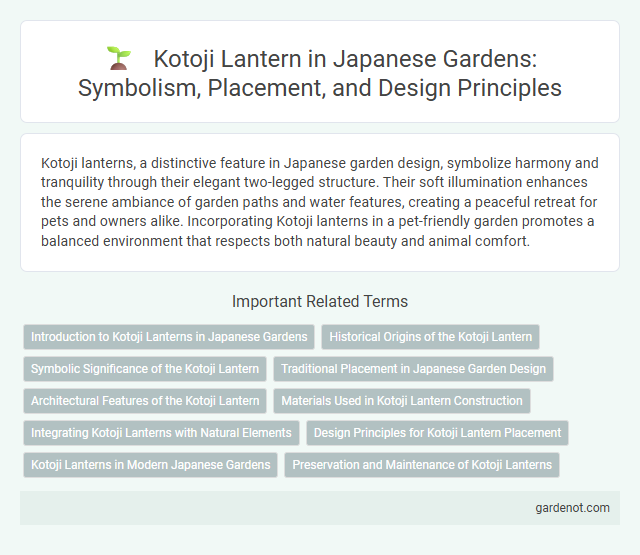Kotoji lanterns, a distinctive feature in Japanese garden design, symbolize harmony and tranquility through their elegant two-legged structure. Their soft illumination enhances the serene ambiance of garden paths and water features, creating a peaceful retreat for pets and owners alike. Incorporating Kotoji lanterns in a pet-friendly garden promotes a balanced environment that respects both natural beauty and animal comfort.
Introduction to Kotoji Lanterns in Japanese Gardens
Kotoji lanterns are iconic stone lanterns commonly found in traditional Japanese gardens, characterized by their distinctive two-legged base resembling the traditional koto bridge. These lanterns, often crafted from granite, serve both aesthetic and symbolic purposes, enhancing garden pathways with soft illumination while representing harmony and tranquility. Their design reflects deep cultural significance, blending functionality with the artistic principles of wabi-sabi, emphasizing simplicity and natural beauty.
Historical Origins of the Kotoji Lantern
The Kotoji lantern, a distinctive two-legged stone lantern found in traditional Japanese gardens, traces its origins to the Edo period (1603-1868), reflecting the aesthetic principles of wabi-sabi and simplicity. Named after the koto, a traditional Japanese string instrument, the lantern's leg-like supports symbolize the musical instrument's bridges, representing harmony between nature and human craftsmanship. This iconic garden fixture was designed to illuminate pathways subtly while enhancing the tranquil and meditative qualities characteristic of classical Japanese garden architecture.
Symbolic Significance of the Kotoji Lantern
The Kotoji lantern, a distinct two-legged stone lantern found in Japanese gardens, symbolizes harmony and balance through its unique design inspired by the koto musical instrument. Its elegant, minimalistic structure reflects traditional Japanese aesthetics and evokes a sense of tranquility and timelessness. Often positioned near water features, the Kotoji lantern enhances the spiritual atmosphere, representing illumination and guidance in the garden's contemplative space.
Traditional Placement in Japanese Garden Design
Kotoji stone lanterns are traditionally placed near water features or along garden pathways to enhance the balance and harmony central to Japanese garden design. Their distinctive two-legged base symbolizes stability and serves as a visual guide, subtly illuminating key garden elements during evening hours. This strategic positioning reinforces the garden's natural flow, blending aesthetics with spiritual significance rooted in Japanese culture.
Architectural Features of the Kotoji Lantern
The Kotoji Lantern, a distinctive architectural feature in Japanese gardens, is renowned for its two-legged stone base resembling the bridge of a koto, a traditional Japanese string instrument. Crafted from granite, it typically features a square light chamber with slotted openings, allowing soft illumination that enhances the garden's tranquil ambiance. This lantern embodies the harmonious blend of natural materials and minimalist design, reflecting Japanese aesthetic principles.
Materials Used in Kotoji Lantern Construction
Kotoji lanterns are traditionally crafted using natural materials such as granite, which provides durability and a timeless aesthetic in Japanese gardens. The granite is often carefully carved to highlight the lantern's distinct two-legged base, symbolizing stability and harmony. Moss and natural weathering further enhance the lantern's integration with surrounding greenery, embodying the principles of wabi-sabi in garden design.
Integrating Kotoji Lanterns with Natural Elements
Kotoji lanterns, characterized by their two-legged stone design, seamlessly blend with the natural elements of a Japanese garden to create harmony and balance. Placing Kotoji lanterns near water features or among moss-covered stones enhances their connection to nature while emphasizing tranquility. The soft light emitted through the lantern's openings accentuates surrounding plants and textures, reinforcing the garden's serene atmosphere.
Design Principles for Kotoji Lantern Placement
Kotoji Lantern placement in Japanese gardens follows the principle of natural harmony, emphasizing asymmetry to mimic nature's irregularity. The lantern is positioned near water elements, such as ponds or streams, to enhance reflective beauty and achieve balance between light and shadow. Placement respects spatial flow, ensuring unobstructed garden views while creating focal points that guide visitors through the landscape.
Kotoji Lanterns in Modern Japanese Gardens
Kotoji Lanterns, characterized by their two-legged base and elegant stone structure, are iconic features in modern Japanese gardens, symbolizing balance and tranquility. These lanterns often illuminate pathways or water features, enhancing the garden's serene ambiance while paying homage to traditional Japanese aesthetics. Their placement reflects careful consideration of spatial harmony, integrating natural elements with cultural heritage.
Preservation and Maintenance of Kotoji Lanterns
Kotoji lanterns, iconic for their two-legged stone base and softly glowing light, require specialized preservation techniques to maintain their structural integrity and cultural significance in Japanese gardens. Regular cleaning with non-abrasive materials, careful protection from weathering, and expert restoration of damaged stone components are critical to ensuring these lanterns continue to embody traditional Japanese aesthetics. Preservation efforts often involve collaboration between horticulturists, stonemasons, and cultural historians to uphold authentic craftsmanship and historical accuracy.
Kotoji Infographic

 gardenot.com
gardenot.com